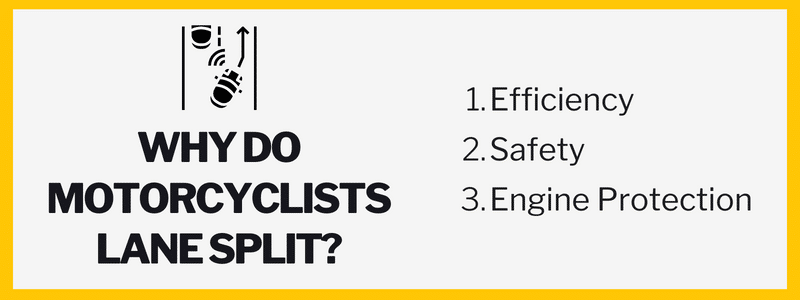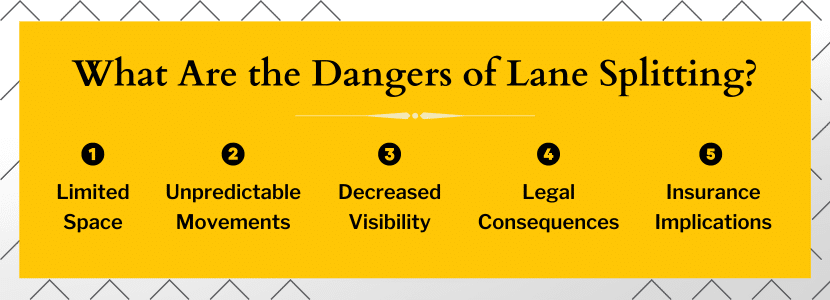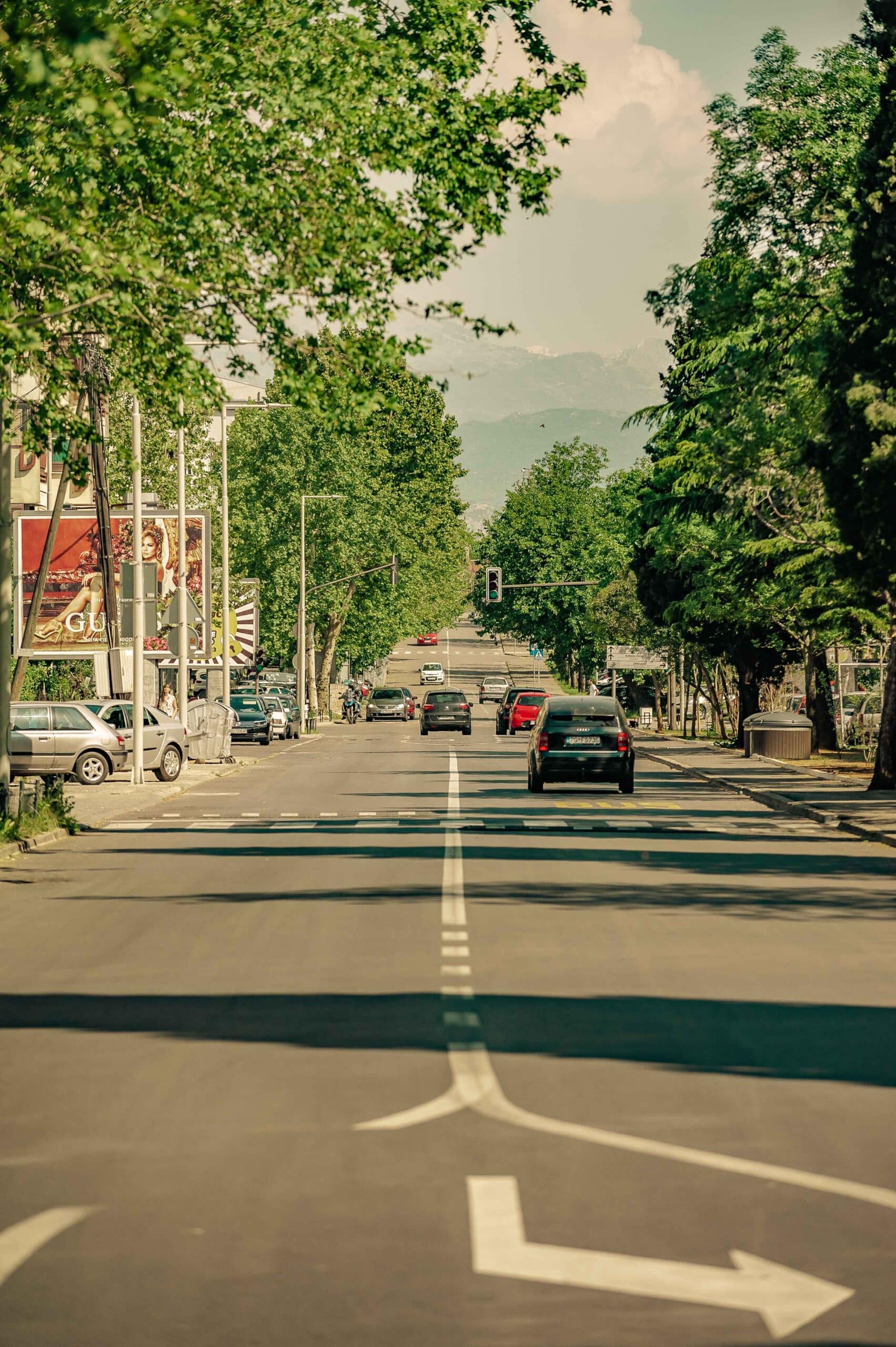For motorcyclists in Louisiana, motorcycle accidents are a leading cause of serious injury and death. Motorcyclists face a disproportionately high rate of fatal crashes compared to other drivers. In 2021, 5,932 motorcyclists were killed – 14 percent of all traffic fatalities – according to the National Highway Traffic Safety Administration.
As a motorcyclist in Louisiana, it’s crucial to be well-informed about motorcycle riding laws and regulations. One particular practice that raises questions and often sparks debate is the act of lane splitting. This article will explore what lane splitting is, the lane splitting legal status in Louisiana, the difference between lane splitting and lane filtering, and where is lane splitting legal.
What Is Lane Splitting?
Lane splitting, often called white-lining or stripe-riding, involves a motorcycle riding between lanes of stopped or slow-moving traffic. This practice enables motorcyclists to maneuver through traffic more efficiently, especially during congested times when they remain in the same lane.
In addition to aiding in avoiding traffic congestion, proponents of lane splitting argue that it can also reduce the risk of rear-end collisions for motorcyclists. However, there are concerns regarding the safety of this practice. Detractors argue that lane splitting can be dangerous as it reduces the space a motorcyclist has to maneuver and can catch other drivers off guard, possibly leading to accidents.
Some studies suggest that lane splitting can be relatively safe when done cautiously and at low speeds, but it becomes increasingly risky at higher speeds or unpredictable traffic. It is essential for motorcyclists who engage in lane splitting to be highly aware of their surroundings and capable of making rapid decisions to ensure their safety and the safety of those around them.
Is Lane Splitting Legal in Louisiana?
In Louisiana, splitting lanes is illegal. Motorcyclists must obey the same traffic laws as other motorists, which means they should occupy a full lane, stay in the same direction, and not maneuver between traffic lanes. Breaking lane-splitting laws in Louisiana can result in fines, traffic citations for reckless driving, jail time, or even more severe consequences if an accident occurs.
Comparative Negligence and Lane Splitting
As Louisiana is a comparative negligence state, this means that if lane splitting riders are involved in an accident while lane splitting, their actions could be considered as contributing to the accident. Comparative negligence takes into account the degree of fault of each party involved in an accident when determining compensation for damages.
In such cases, the motorcyclist’s entitlement to compensation could be reduced proportionally to the degree to which their lane splitting contributed to the accident.
Impact of Lane Splitting on Insurance Claims
Engaging in lane sharing or splitting may also impact insurance claims. Insurance companies might view lane splitting as a high-risk behavior and could deny or reduce coverage based on the motorcyclist’s involvement in such actions.
It’s also worth mentioning that public perception plays a role in splitting lanes. Many drivers are not accustomed to motorcycles passing between lanes or lane sharing, which can lead to frustration or aggressive driving behavior, which can escalate road risks and cause further negligence that may impact an insurance claim.
Importance of Legal Compliance for Motorcyclists
For motorcyclists in Louisiana, it’s imperative to be knowledgeable about and compliant with state traffic laws to ensure their safety and the integrity of their legal and financial standing in case of motorcycle accidents.
The Louisiana Highway Regulatory Act provides a clear overview of the regulations and penalties for operating motorcycles on roadways laned for traffic. Upholding these standards helps maintain a safer riding environment for all.
What is the Difference Between Lane Splitting and Lane Filtering?
While lane splitting involves maneuvering between slow-moving or stationary traffic lanes, lane filtering differs slightly.
Lane filtering refers to a motorcycle moving between lanes to the front of traffic stopped at an intersection or traffic light.
Though similar, these practices are distinct, and their legality varies across states. However, lane filtering, like lane splitting, is illegal in Louisiana.
Why Do Motorcyclists Lane Split?
Motorcyclists often resort to lane splitting for various reasons:

1. Efficiency
One of the primary reasons why motorcycle riders split lanes is efficiency. It allows them to bypass traffic congestion, saving time. When traffic is moving slowly or is at a standstill, motorcycles, due to their size, can move through the spaces between vehicles. This can be particularly beneficial during rush hour when traffic is most congested. For commuters who use motorcycles, this can translate into significant time savings. Additionally, by taking up less space on the road, motorcyclists who split lanes may contribute to the overall easing of traffic congestion for all road users.
2. Safety
Though it might seem counterintuitive, lane splitting may enhance safety for motorcycle riders in certain instances. For example, in stop-and-go traffic, motorcycles are at a higher risk of being rear-ended by inattentive drivers. By moving between lanes, they can position themselves in a more visible location and avoid staying directly in front of a vehicle, reducing the risk of a motorcycle accident. However, this practice demands that the motorcyclist be very alert and able to navigate marked traffic lanes safely and through tight spaces.
3. Engine Protection
Motorcycles, especially air-cooled engines, are susceptible to overheating when not moving or moving very slowly for extended periods. This is because their cooling system relies on air moving across the engine. Lane splitting allows for better airflow around the engine than idling in traffic, which can help prevent the engine from overheating. This benefits the motorcyclist’s immediate comfort and contributes to the motorcycle engine’s longevity and maintenance.
In What States Is Lane Splitting Allowed?
California and Arizona are the only states presently where lane splitting is explicitly legal, although there have been attempts to legalize lane splitting in other states.
In California, motorcyclists can travel between lanes of slow-moving or stopped traffic. However, there are guidelines to ensure the safety of both motorcyclists and other road users. For example, in California, the recommendation is that motorcyclists not exceed the speed of surrounding traffic by more than 15 miles per hour and not lane split when traffic flows at or above 50 miles per hour.
Knowing which states allow lane splitting and where is it legal to lane split can help save you from legal complications.
If you’ve been injured in a lane splitting motorcycle accident due to someone else’s negligence, a motorcycle accident lawyer can help protect your rights and work to make sure you receive the compensation you deserve.
Where Is Lane Filtering Legal?
Lane filtering is legal in a few states, though the laws and specifics may vary. Lane filtering in the U.S., unlike other lane splitting legislation, generally refers to the practice of a motorcycle moving between lanes of stopped traffic, such as at a red light or in heavy traffic jams.
Below are states and countries overseas where lane filtering is legal. Remember that laws change frequently, so it is important to double-check current regulations.
1. Lane Filtering in Utah
Utah was one of the first states to legalize lane filtering in 2019. The law allows motorcyclists to filter between lanes of stopped traffic under certain conditions. Specifically, lane filtering is permitted on roads with a speed limit of 45 miles per hour or less, the motorcyclist must not exceed 15 miles per hour while filtering marked traffic lanes traveling together, and the traffic must be stopped.
2. Lane Filtering in Montana
Montana passed a law in 2021 legalizing lane filtering under specific conditions. Like Utah, motorcyclists can filter through traffic that is stopped. The stipulations in Montana are that the road must have speed limits of 50 miles per hour or less, and the motorcyclist must not exceed 20 miles per hour while filtering.
3. Lane Filtering in Europe
Overseas, lane filtering is more commonly allowed, especially in European countries. In fact, in countries like Italy and France, drivers are more aware of motorcyclists on the roadways and expect lane filtering in heavy traffic. In countries like Germany, however, while lane filtering is legal, it is only welcome if traffic moves at less than 7 miles per hour.
What Are the Dangers of Lane Splitting?
Though lane splitting can have benefits, it also has potential dangers, especially if the other drivers are unfamiliar with how to react to motorcyclists in close proximity or there’s decreased visibility.

Limited Space
From a legal perspective, the narrow space between lanes can make maneuvering difficult, which could contribute to liability issues in the event of an accident.
Suppose a motorcyclist is involved in a collision while lane splitting, the confined space could be seen as a contributing factor to the accident. Courts or insurance companies may question whether the motorcyclist exercised reasonable care in navigating through such tight spaces, which may impact the determination of fault.
Unpredictable Movements
The unpredictable movements of cars, such as sudden lane changes or opening doors, present a physical hazard and a legal challenge.
Establishing liability can be complicated if an accident occurs due to a car changing or splitting lanes or opening a door. While the car driver may be at fault for not checking mirrors or signaling, the motorcyclist might also be seen as assuming a level of risk by engaging in lane splitting, particularly in states where it is not explicitly legal.
Decreased Visibility
Decreased visibility of motorcyclists when lane splitting can have legal implications, especially in the context of insurance claims and liability determinations. Suppose a motorcyclist is less visible while lane splitting and gets into an accident. In that case, insurance companies may argue that they contributed to the accident by placing themselves in a position where they could not be easily seen. A lack of visibility may also result in a reduced insurance payout or even denial of a claim.
Legal Consequences
In states where motorcycle lane splitting is not expressly legal, motorcyclists who engage in this practice can face numerous legal consequences. When something isn’t expressly legal, it means that while there may not be a specific law permitting the activity, there’s also no law explicitly prohibiting it. However, this gray area doesn’t grant immunity from potential legal repercussions, as behaviors falling within this category can still be deemed unlawful under certain circumstances or interpretations of the law.
The legal consequences of motorcycle lane splitting might include fines, points on the driver’s license, and even an impact on personal injury claims should an accident occur. If lane splitting is viewed as negligence or reckless behavior in a state where it’s prohibited, it can significantly limit a motorcyclist’s ability to recover damages.
Given the substantial legal risks, motorcyclists should stay well-informed about lane splitting laws in the regions where they ride. Additionally, the potential hazards associated with lane splitting should be carefully considered, with riders exercising extreme caution if they engage in this practice.
Insurance Implications
Insurance coverage is another crucial factor in the lane splitting equation. When a motorcyclist is deemed at fault in an accident while lane splitting, the insurance company may decide not to cover the damages inflicted upon the other party due to the rider’s negligence. This situation could lead to significant out-of-pocket expenses.
That’s why motorcycle riders must be sure that their insurance policy covers the unique risks associated with their mode of transportation, including potential issues arising from lane splitting if it’s legal in the state where the vehicle is operated. Besides, maintaining comprehensive insurance coverage contributes to a safer and more responsible riding experience.
Take Charge of Your Defense: Seek Legal Expertise for Lane Splitting Charges and Personal Injury Claims
If you’re a motorcyclist in Louisiana and find yourself facing charges related to lane splitting, or if you’ve been involved in an accident while lane splitting, it’s imperative to seek legal counsel. Understanding the legalities of lane splitting and the states where you can lane split is crucial.
Similarly, knowing the answer to the question “why is lane splitting illegal” can save you from trouble if you plan to ride through different states.
The Law Offices of Blaine Barilleaux are experienced in motorcycle laws and can help you navigate the complex legal landscape surrounding lane splitting regulations. Don’t let a misunderstanding of the law affect your rights and freedom.
Contact us today and watch us fight for your rights!







